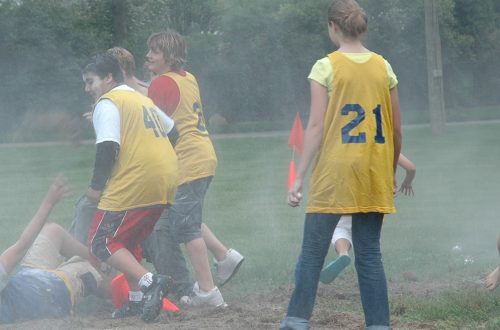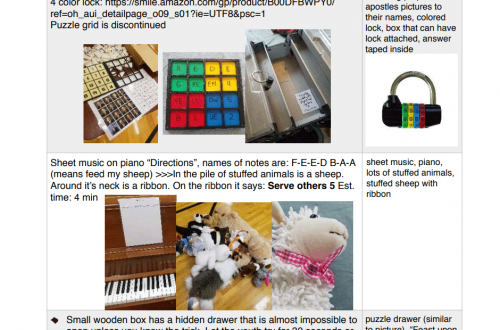72 Hour Emergency Supply Kits
From a post that no longer exists, but is archived here: http://web.archive.org/web/20140814220547/http://www-suares.stanford.edu/72hour-kit.html
From: dorothy@cogsci.berkeley.edu (Dorothy Heydt)
Newsgroups: ca.earthquakes
Subject: 72 Hour Emergency Supply Kits (**LONG**)
Date: 6 Nov 89 18:39:20 GMT
Organization: University of California, Berkeley
Lines: 713
I have just been taught how to post. Here is the information that I
have put together from a number or sources on the preparation of 72
hour kits. It is very long. Hope the information is useful to anyone
who needs it.
IDEAS FOR FOOD FOR 72 HOUR KITS
01. Package each meal for each member in individual bags.
Breakfast Day 1
Lunch Day 1
Dinner Day 1
etc…
This prevents any loss of food for any one person in your party
and allows you to keep order in your kits.
02. Pick foods your family will enjoy.
You will find that it is very important that you place foods in
this kit that your family will eat regardless. You might plan to
place foods in your kits that your family particularly enjoys,
but that you don’t always serve.
03. Rotate your food.
Most food comes with expiration dates on it. It will be impor-
tant to rotate your food according to this schedule so that you
do not find yourself in an emergency situation with expired food.
04. Place food in your kits that are easy to prepare or ready to eat.
When you need to use this kit, remember you will have in most
cases been evacuated from your home either by car or on foot. It
will be a stressful time for your family. You may be in a Red
Cross Shelter, in a campground or on the road or on the way to
relatives homes. You will not have all the luxuries of home.
Cooking at best will be difficult. Please keep this in mind as
you choose your foods for this 72 emergency survival kit.
05. Don’t spend a lot of money.
This is a survival kit. You will want to be comfortable but not
extravagant. The food you place in here, due to its convenience,
will cost more than you desire to spend, however, you can keep
the cost very reasonable.
06. Ideas for Food.
Beef Jerky Saltine Crackers
Corned Beef Hash Soup-for-One
Roast Beef Hash Cheese & Crackers
Beef Stew Oyster Crackers
Chili Dried Beef
Ravioli Fruit Cups
Applesauce Cups Vienna Sausages
Pudding Cups Bread Sticks
Cookies Snack Pack Cereal
Canned Milk Powdered Milk
Fruit Rolls Fun Fruits
Packages of Raisins Packages of Peanuts
Granola Bars Beef Sticks
Box Juices Hot Cocoa Mix
Suckers Hard Candy
Trail Mix Power Bars
This list is just to give you some suggestions for putting
together your own kits. As each families taste differ you will
need to adjust for your own families taste.
07. Menus – Examples
Breakfast-Day 1 Breakfast-Day 2 Breakfast-Day 3
————— ————— —————
Cereal Instant Oatmeal Granola Bar
Powdered Milk Fruit Roll Granola Bar
Fruit Cup Box of Apple Juice Box of Grapefruit Juice
Box of OJ Hot Cocoa/Ice Tea Hot Cocoa/Ice Tea
Lunch-Day 1 Lunch-Day 2 Lunch-Day 3
———– ———– ———–
Cup of Soup Beef Jerky Box of OJ
Saltine Crackers Peanuts Cheese & Crackers
Box of Apple Juice Applesauce Cup Fruit Cup
Pudding Cup Box of Grape Juice Granola Bar
Dinner-Day 1 Dinner-Day 2 Dinner-Day 3
———— ———— ————
Corned Beef Hash Chili with Beans Beef Stew
Applesauce Cup Saltine Crackers Bread Sticks
Box of Grape Juice Box of OJ Box of OJ
Granola Bar Tapioca Pudding Cup Fruit Cup
EMERGENCY FUEL
CANNED HEAT (STERNO) – This can be purchased at most sporting
goods stores as well as most grocery stores. You will need to
store 1 large can per person per day.
BUDDY BURNER – Select a shallow can (tuna, cat food, etc.) and
insert coil of corrugated cardboard the height of the can.
Pour melted paraffin to partially fill can. Allow to harden.
Birthday candle in center will help light. A lid on the can with
a wire handle will help control the heat.
VAGABOND STOVE – Use a number 10 can. Cut opening around the top
of the can with a can opener punch. This is to provide a draft
for your fire. Then cut an opening at the bottom of the can
large enough to fit the Buddy Burner or a small fire. Cook on top.
FUEL CONSUMPTION AND BURNING TIME
Lighting Equipment
GAS LANTERN (Coleman, two mantle)
Burning at the rate of 5 hours per day, the following amounts of
white gas would be used: Per day – 5/12 quarts; per week – 2
12 quart per month – 3 1/8 gallons; per year – 38 gallons.
KEROSENE LANTERN – (with a 1″ wick)
This device will burn 45 hours on 1 quart. (Dietz Lantern
Information) burning at the rate of 5 hours per day, the following
amount of kerosene would be used: Per day – 1/9 quarts; per week
7/9 quarts; per month 3 1/13 quarts; per year – 10 gallons.
FLASHLIGHT (Two battery)
Batteries used were well-known brands in testing). Continuous
running on new batteries – 7 hours. 7 month old batteries,
continuous running – 5 hours.
CANDLES (Burning time)
3/4 diameter x 4″ tall – 2 hours and 20 minutes
7/8 diameter x 4″ tall – 5 hours
2″ square x 9″ tall – 7 hours per inch or : 4 inches – 28 hours
9 inches – 63 hours
Heating or Cooking Equipment
TWO PLATE GAS BURNER (Coleman)
With both burners burning for 4 hours per day, the following
amount of white gas would be used: per day – 1 quart; per week –
7 quarts; per month – 7 1/2 gallons; per year – 91 gallons.
CAUTION: DO NOT STORE WHITE GAS, KEROSENE, & SIMILAR FUELS IN THE
HOUSE OR WITHIN THE REACH OF CHILDREN. Consult distributors of
fuel, or government agencies that would have information on the
proper storage of fuels.
INTRODUCTION WHY A 72 HOUR SURVIVAL KIT?
What will you do if disaster strikes your neighborhood: a fire,
a riot, a flood, a tornado, a hurricane, or an earthquake? The
most critical need for help after the disaster is during the first
72 hours, yet community and government assistance will probably
not be available during this period.
YOU AND YOUR FAMILY WILL BE ON YOUR OWN!
With a minimum of expense and trouble it is possible to bring
together a few basic items which will ease the stress of a
difficult situation and may even save you and your families life.
In any form of emergency situation, several things take place:
both physical and emotional.
1 – We will all experience emotional shock and a cer-
tain amount of hysteria.
2 – The propensity of accidents increases.
The greatest threat to loss of life are accidents
that lead to severe bleeding or other forms of
injury or trauma.
If we are not able to address these injuries as effec-
tively as possible, this will greatly increase our own
stress and could virtually debilitate some people and
prevent them from acting in a sound and rational man-
ner.
We must keep in mind that in the event of a severe disaster, all
familiar public services, including medical, will be immediately
over-taxed and as a result, will be basically ineffectual to you
as an individual, particularly during the first 72 hours.
Assistance Organizations such as the Red Cross, Hospitals, the
Military, National Guard, etc., require a certain response time
They are looking to you to take care of yourself and your family
completely for a period of a few hours up to 72 hours. It takes
approximately 72 hours until their operations are in full service.
HOW TO PACK IT…HOW TO STORE IT
It is important that you take a comprehensive survey of your own
family units needs and insure that you have included any special
items that are unique to you. Your needs could be very much
different than the suggested lists, only you can decide what you
and your families needs are based on your resources and experi-
ences.
Once you have established and gathered together what you feel are
necessary requirements for both an Emergency Preparedness Kit and
a substantial First Aid Kit; you will need a container that these
items will go in.
1- Fishing Tackle Boxes
2- Tool Boxes
3- Sweater Storage Boxes
4- Rubbermaid Tote and Go
The items listed above are ideas for storing your large First Aid
Kit.
These boxes need to withstand the rigors of rapid transportation.
Please keep in mind that none of the items you gather together
are of any value to you if they cannot be brought to the point of
need and be in useable condition and render the service that the
items were intended for.
1- Rubbermaid Tote and Store
2- Suitcase
3- Footlockers
4- Plastic Garbage Cans
5- Corrugated Cardboard Boxes
The items listed above are ideas for storing your 72 hour emer-
gency kit.
These kits do not have to be complicated! Rather, simple is
better than complex, however, the need of quality and durability
should be one of the major criteria for any items included.
WATER STORAGE
The Civil Defense Bulletin Reads:
“Water to be stored should be drawn into containers
before it is needed. Don’t wait until an emergency
happens before laying in your supply. When an emergen-
cy occurs, it may be to late to act. The public water
service may already be interrupted or contaminated.
Also, if thousands of households are trying to fill
water containers at the same time, they would reduce
the pressure in the street mains. This would make fire
fighting more difficult. Waiting until something
happens before you draw and store the water you need
could cost you your home or even your life.”
Be Careful About Rain Water –
Rain water that has been collected should be treated
the same as any other unknown water source. Rain
water contains small particulates and acid.
Good Methods of Storing Water –
Store Bottled Water – may be stored up to six months
with no detrimental effect or rotation required.
Store Water in Old Bleach Bottles –
Rotate every 7 to 9 months.
| Do not rinse the Plastic Chlorox Bottles
before filling with water. You should not
get ill from drinking this water as the resi-
due left in the bottle is probably just the
right amount of chlorine to protect the wa-
ter.
Purchase five gallon water containers from a camping
supply store or Army Surplus store. Keep in mind,
however that you will need to transport this and possi-
bly on foot so consider the weight involved if you
choose this method. Water weighs approximately
| 8-9 pounds per gallon. (actually 8.3 pounds, not including
| container.)
Water Purification Methods –
Boiling- Most water can be purified for drinking pur-
poses by boiling it for 10 minutes. This
will destroy the bacteria. In order to im-
prove the taste it will be necessary to aer-
ate it after boiling. This is accomplished
by pouring it from one container to another
several times. This should be done after the
water has been allowed to cool.
Chlorination- You can use any commercially available bleach
solution. It should contain 5.25% Sodium
Hypochlorite. Add the following to a clean
container in which when the water is added.
It can be thoroughly mixed by stirring or shak-
ing.
4 drops per gallon
20 drops = 1/4 tsp or
enough to purify 5 gallons.
After adding the proper dosage and stirring,
allow the water to stand for 30 minutes. It
should then have a distinct odor of chlorine.
If this odor is not present, add another dose
of the solution and let stand for another 15
minutes.
The taste or smell or chlorine in water as
treated in this manner is a sign of safety.
It is not harmful. On the contrary, if you
cannot detect chlorine in water you are try-
ing to purify by this method, do not drink
it.
Purification Tablets –
Tablets that release iodine may be used safe-
ly to purify drinking water. These tablets
can be found at most drug stores and sporting
goods stores. The names vary but it is ge-
nerically known as halazone tablets.
Follow the directions on the package.
Usually one tablet is sufficient for one
quart of water. The dosage is doubled
for cloudy water.
Iodine – Ordinary Household Iodine may be used to
purify small quantities of water. Add 2-3
drops of Tincture Of Iodine to each quart of
clear water (8-10 for cloudy water). Mix and
allow to stand for 30 minutes.
Other purification methods may be recommended by the proper
authorities if special conditions arise. In such cases follow
the instructions of your local government or authorities.
It is suggested that each member of your household have a minimum
of 1.5 gallons of water per day. This is including infants
(nursing mothers will need more). It is suggested then, that you
store 4.5 gallons per member of your family for your 72 hour
supply.
PROPER SEWAGE DISPOSAL
I know that most of you do not want to consider the possibility
of having to leave your home and then rough it even to the point
of having to be responsible for the dispose of your wastes,
however, the possibility exists and the following will help you
to take care of this unpleasant task in the proper and safest
manner.
You will need 12 to 18 large brown paper bags for each
person for each day. This allows the use of 4 to 6 bags
each time for 3 times per day.
You will place the bags 4 to 6 thick (one inside the other).
Spray Disinfectant
Newspapers and Toilet Tissue
Insecticide
Pointed Shovel
The bags are called soil bags. Paper is preferable to plastic
because of their biodegradable properties. You will place these
bags one inside the other and spray with a disinfectant. Then
fold up 2 sheets of newspaper and place in the bottom of the bag.
Place this bag in the hole that you will use.
After use pour 1/4 cup bleach into bag or douse with lysol then
tie the bag shut with a piece of twine and spray the bag with
insecticide. If you are moving on, dig a hose 30 to 36 six
inches deep and bury the bag. Make sure that you cover it well
with dirt and then stomp on the dirt to make sure that there isn’t
any air-gaps in the hole.
If you have made camp and will be staying you can place all the
soil bags in a large plastic bag with a tie on it and place it in
a large trash can that is not being used for garbage. Then at
the end of the day, all the paper bags can be buried at one time.
WHAT DO I NEED?
INSTRUCTION MANUALS ON EMERGENCY PREPAREDNESS – This is a start.
It can be reviewed with family members. Further information is
available to you at your local library.
BATTERY POWERED RADIO – Local stations and the Emergency Broad-
cast System will be the only source of reliable information
during an emergency.
If the radio is a permanent addition to your 72 hour kit it
should be checked regularly to make sure both it and the batter-
ies are in working order.
FLASHLIGHT – These should be stored outside of the radio and
flashlight. The shelf life can be extended if the batteries are
kept in the refrigerator or freezer.
FAMILY RECORDS AND VALUABLES – Birth Certificates, Naturalization
Papers, and Diplomas, Insurance Certificates, Genealogy Informa-
tion, Computer Disks, Passports, etc.
ITEMS FOR STRESS MANAGEMENT – After the initial response to an
emergency, the disrupted life style and disorientation can cause
undo emotional stress and feeling of insecurity. Items that are
emotionally reassuring should be included in the emergency kit.
These can include crayons, coloring books, story books, puzzles,
soft small toys for children. Personal items for adults should
be included such as books, handiwork, musical instrument, or
sports equipment.
PLASTIC BAGS AND TIES – These items can serve as garbage contain-
ers, ground cloths, tents, wash basins, broken window cover, and
substitute rain coat.
DISINFECTANT – Bleach, lysol, betadine can be used to treat
sewage, waste water, and refuse to minimize infection. Storage
containers for these items must be unbreakable.
IMPROVISED TOILET – Pack a pointed shovel, and a plastic bucket
with a tight fitting lid. Pack 12 to 18 paper bags per person
per day. Sanitation is the most important consideration.
Remember to also pack the toilet tissue.
PAPER CUPS, PLATES, BOWLS and DISPOSABLE UTENSILS – This will
help you to conserve water and at the same time minimize contami-
nation problems.
PAPER TOWELS
SOAP – Liquid soap (soft soap or pump ivory) works best when
water supplies are limited.
FEMININE HYGIENE NEEDS
DISPOSABLE DIAPERS
MEDICATIONS FOR THREE DAYS (72 HOURS) FOR EACH MEMBER OF THE FAMILY
TOILETRIES – Although these are not necessary for survival they
will contribute to a sense of well-being and comfort. Toothbrush
and toothpaste, comb and hair brush, washcloth and towel, deodor-
ant, shaving supplies and mirror, shampoo and mouthwash.
FIRST AID KIT – It is assumed that major medical needs will be
taken care of by community resources. The community has a plan
which will deploy paramedics, fire departments, police, and other
medical personnel as needed to areas where major injuries have
occurred.
The purpose, therefore, of the items included in the family First
Aid Kit is to treat minor injuries so that they do not become a
major threat to health during the first few days of an emergency.
WATER STORAGE – General Water Storage is 1.5 gallons per person
per day.
SLEEPING BAGS and BEDROLLS – Wool blankets resist fire, they warm
even when wet and they are less bulky than sleeping bags. There
must be adequate and appropriate sleeping cover for every member
of the family.
FIRE EXTINGUISHER
CAN OPENER – A manual type must be packed with any canned goods.
UTILITY KNIFE – A sharp versatile knife will come in handy for
many purposes.
ADJUSTABLE WRENCH – This must be kept handy to gas and water
lines. Each member of the family should be trained how to turn
off gas or water in the event of an emergency. Turning off water
not only prevents damage to one’s home, but also provides in-
creased water pressure for community use.
Water trapped in the hot water tank and indoor plumbing will stay
clean once the main water valve is turned off.
EXTRA CHANGE OF CLOTHING and UNDERWEAR FOR EACH FAMILY MEMBER
MISCELLANEOUS – Small Ax, Heavy Gloves, and MATCHES stores in a
waterproof unbreakable container.
SOS
In the case of most emergency’s there will be little if no
communication over telephone lines.
It is imperative that all members of your family learn to send
morse code SOS. This is the universal sign for HELP.
It can be sent many ways, by signal mirror, lantern, key and
whistle.
It is very simple, however, care must be taken to insure that
each member knows how to send it and receive it. You must
practice this skill if you are to retain it.
S (dit dit dit)
O (dah dah dah)
S (dit dit dit)
Dits are very short blasts of light or sound.
Dahs are longer (3x that of dits) of light or sound.
CHILDREN’S SURVIVAL KIT
Store these items in water proof containers. A plastic bucket is
ideal for this. Make it accessible to your emergency kits.
Suggested Items:
01. Scriptures
02. Books & Magazines
03. Paper, Coloring Books, and Activity Books
04. Felt Tip Markers, Colored Pencils, Scissors
05. Games
06. Small toys
07. Any Hard Candy
08. Children’s Vitamins, Pain-Reliever, Cold Remedies, Band
Aids, and First-Aid Cream
09. Creative Game List
10. String
11. Clothespins
12. Feather
13. Straws
14. Wooden Blocks
15. Marbles
16. Metal Washers
CREATIVE GAME LIST
This is a list of games that children can play out of everyday
items.
Clothespins –
01. Drop in a bottle
02. Pitch at a target
03. Clothesline relay
Wooden Blocks –
01. Print letters on cubes. Roll cubes to spell words.
First one to complete 10 words wins.
Marbles –
01. Roll them at a target
02. Toss them in a box
03. Old Fashioned Marble Game
Metal Washers –
01. Toss them into numbered cups.
Paper Cups –
01. Tossing Games
02. Blowing Relay
03. Telephone
Paper Plates –
01. Toss through a wire coat hanger
Straws –
01. Marble Blow Relay
02. Bean Relay
Spoons –
01. Carry Ball
02. Flip Beans at target
03. Carry Cotton Balls
Feathers –
01. Feather Volleyball: blow feather over string or net
02. Toss them at a target
03. Blow them over the line relay
If you have any further need of information post or e-mail to me and
I’ll try to find the answers for you. Our kits are homemade and we
keep them in small backpacks (2 for each person) and the water in
portable containers. My Husband’s backpack is in his vehicle as he is
on the road most of the time. He keeps the first aid kit (extensive)
with him as he is a volunteer EMT. I have the children’s packs right
by the front door in a closet, along with the family first aid kit.
We keep an extra set in my car. By having an extra in the car – if
you come across an accident or someone who is stranded with a broken
vehicle – you can offer some assistance (i.e. blanket, flashlight food,
or water).
All of my children have been assigned jobs – one thing that they need
to do in case of emergency or evacuation. We routinely practice these
items. Then they pick up their kits and meet at the assigned meeting
point.
We have only had to leave once – it was during a fire when we lived in
Southern California. We were gone overnight. It was good to have
things that the children felt comfortable with. We returned home with
no incident.
Hope this helps.
Karen.



